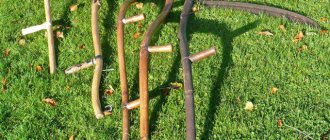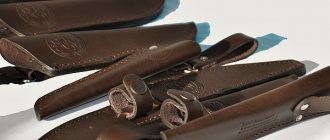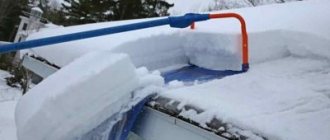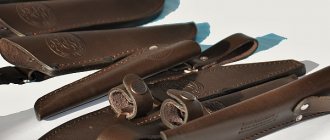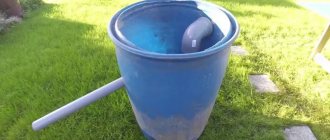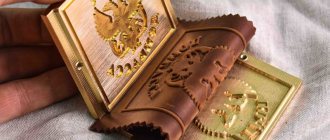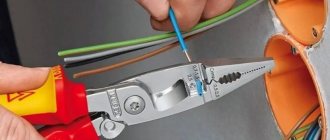A. Pivovarchik DZ braid!
ABOUT KOSOVISHCHE ITSELF
® Kosovischa (Fig. 1) are made in our area from young spruce. It is advisable to select a tree of such size that it requires less planing. They cut down a Christmas tree in winter (the tree is stronger). The spruce is dried in the bark and not in the sun, so that there are fewer cracks. They make braids from birch, and sometimes from pine. Less commonly planed from ash. These are already masters who respect their in-
For the handle of the scythe, select a rod (made of oak or buckthorn) of small length, but with a margin, so that the final size can be determined later according to the hand. The diameter of the rod is about 3 cm. A small depression is cut out in the middle of the rod (Fig. 2, a) in the form of a trough (the thickness of the part remaining after trimming is approximately 1/3 of the diameter of the rod). Before bending an oak rod, it is better to boil it (at least
tools and those who know how to hold a plane, choose ash for the scythe. The lower part of such braids is hexagonal, the upper part is round. Such braids are planed not from thin wood, but from blanks that are obtained by splitting the trunk of an adult ash tree.
The length of the mower depends on the height of the mower and is usually 15–20 cm greater than this height.
bend point) in water for 5 minutes. 10, and then bend it around a round mandrel with a diameter of about 3 cm.
A buckthorn rod can be heated (in the bark) over a fire by pouring a little water into the cut out trough. When the bark burns, the rod is ready for bending. If the pen doesn't work out the first time, don't despair! The second one will definitely come out better! When the curved handle dries, it is cut
How to do something yourself, with your own hands - home craftsman website
AN EXCELLENT TOOL FOR CRAFTS AND HANDCRAFTS AND EVERYTHING FOR THE GARDEN, HOME AND Cottage LITERALLY FOR FREE - SEE FOR YOURSELF. THERE ARE REVIEWS.
I started mowing by hand with a regular scythe at the age of 12 – my father taught me this art. Now I’m 75, I can no longer completely cultivate my plot in this way, and I switched to mowing with a lawn mower of my own design.
But he didn’t throw away the old lady’s braid!
From time to time, to remember my youth and warm up a little, I pick it up. I think it will always come in handy at the dacha, at least for mowing large weeds that neither a lawn mower nor a trimmer can handle. Therefore, I want to share my mowing experience.
First of all, you need some basic information about the braid itself. This is a tool consisting of a knife, a scythe, a handle and a mounting device for the knife on the scythe (Fig. 1 and 2).
TOOLS FOR HOME AND GARDEN, HANDCRAFTS, ETC. PRICES VERY LOW
According to GOST (which, despite all the events of recent decades, no one has canceled), a knife must be made from tool steels of grades U7A, U8 and U8A. It must be heat treated. The knife itself includes the elements shown in Fig. 3. However, the quality of the knife is not always at its best (here they are, the results of modern times). Therefore, before purchasing, you need to carefully examine it. There should be no cracks, delaminations, depressions or protrusions on the surface.
The blade of the knife should be smooth and of equal thickness in sections.
This is checked by attaching some small even plates to the canvas, for example metal corners.
Next you need to check the heat treatment. Holding the knife by the heel, hit it on the butt with a solid wooden object. A clean, clear sound indicates good quality metal. If the ringing is dull and intermittent, then such a knife is unlikely to serve you well.
Another test: holding the knife by the heel, place its nose against a wooden surface and apply light pressure. If the canvas bends evenly and returns to its original shape after removing the load, then everything is in order. If there remains a deflection, it means that the heat treatment of the knife was done extremely poorly. You can also check it with a nail. Run it across the blade. If the metal is well-hardened, then small shavings will be removed from the nail. If it slides and there are no chips, then it is better not to take such a knife. Manufacturers can also save on blade sharpening.
This is easy to check: run a flat, finely grooved file along the blade. If everything is normal, the file slides; if not, it removes chips from the metal.
The scythe will not find the stone
The braid must be elastic and durable. When buying a ready-made product, make sure that there are no bends, knots or other defects on it. Its length should be 1700-2000 mm, cross-section – 40×40 with chamfers along the length to thickening. In the middle of the thickening, a handle is installed in the direction opposite to the bevel, under the installation of the knife - at the level of the mower’s navel, with a slight inclination to the right from the cutting plane (Fig. 4).
Tips for choosing from an expert
There is no need to be shy and ask the seller all your questions. The further choice and purchase of the equipment needed on the farm depends on this, and what quality it will have completely determines the mowing speed, quality and effort expended.
There are several secrets that will help you choose a truly worthwhile hand braid:
- Sound test - you need to take the scythe by the heel and hit the wooden object with maximum force. If a clear, deep ringing is produced that lasts at least 3 seconds, such a unit deserves attention. A dull, dull sound that disappears in a second indicates incorrectly chosen parameters of the canvas, in particular its thickness.
- Chip test - take a sharp nail and run it along the blade of the scythe. If small chips are formed, then such a braid is made of poor metal, which will be susceptible to corrosion and quickly wear out during operation.
- Glass test - take any glass object that has a smooth surface, apply it to the blade and run it across it. If the glass clings to the metal in certain areas, it means that the metal chosen is of low quality.
Such recommendations will help you avoid buying fakes and homemade products, which in practice do not have all the qualities of real garden equipment.
Experts in the field of making hand braids emphasize the importance and necessity of proper care. It is this factor that determines the longevity and quality of operation of the tool.
You should:
Use only a suitable sharpening stone - it is strictly forbidden to sharpen the scythe with electric sharpeners with a rough finish, as this will lead to scarring on the blade. After using the scythe, you need to clean the blade from dirt and put it in a dry place, taking all precautions. Winter storage involves dismantling the braid and storing the web in a special cotton case.
These tips will help you maximize the life of your hand scythe.
You can make a braid with your own hands
The best material is young spruce. It is dried in a vertical position in the shade. The wedge is made from durable dry wood (acacia or oak).
The handle can be made movable (Fig. 5). To do this, use a freshly cut willow or bird cherry branch. Then it is bent along a circular braid and secured with twine. At the bottom of the braid, a cut is made to install the heel of the knife.
Its slope is chosen in this way: place the mower on a level surface in the mowing position with a pre-installed knife. The blade lift should be 10-20 mm. After making the bevel, apply the heel of the knife and mark where the tenon should be recessed (Fig. 6 and 7).
Gripping the scythe is important. It depends on the hardness, density and juiciness of the grass and is installed using a cord (Fig. 8). For softer grasses, a positive grip is set between 0 and 20 mm. For hard grasses, the grip is set to negative. In this case, you can mow with less effort and with better quality.
A bit of poetry and a historical excursion
Before starting production, a small conclusion about the rarity of the products. If you look back, many historians claim that in villages, blades were always made from broken braids for household use. It is clear that 100-150 years ago metal was not widespread. It was difficult for a simple peasant to get even a small piece. And in order to save money, nothing was thrown away and went into use.
And at the same time, having studied today’s selection of braids for use in gardening purposes, and most importantly, their price: 500-600 rubles. We can draw a fairly simple conclusion that in a braid 50 cm long and 10 cm wide, plus a handle, not the best steel is used, but ordinary stamping.
Accordingly, a scythe with “tin can” steel is not suitable for making a blade. A real, rustic, blacksmith-forged scythe is difficult to find today, and it is more likely to be valued more as an antique than as a consumable for a blade. It is known for certain that steel for scythes was cast and then forged like a sword. And such a scythe was called “Lithuanian”, and it was valued as a military weapon. This happened literally 1.5 centuries ago.
Folding knife made from scythe.
Products originally from the USSR were made by hand and in factories, and the steel used there was quite good. Its quality can be easily compared with files from the same times or drills. In the 50-70s of the 20th century, the quality had not yet fallen, and it was just a joy to make a blade from such a scythe. The difficulty is finding it.
Sharpening, beating and attaching the braid
Fig. 1. Scythe device: 1-knife. 2-braid, 3-handle. 4-wedge, 5 – rings, 6 – thickening.
Option for attaching the knife to the brace with 2 screws and a bracket: 1 – brace, 2 – heel of the knife, 3 – bracket, 4 – M6 screw, 5 – M6 nut, b – spring washer.
Option for fastening the knife with a bracket: 1 – bracket, 2 – bar, 3 – screw MB -1. Rice. 2. Attaching the scythe knife
Rice. 3. Knife structure: 1 – blade, 2 – spine, 3 – blade, 4 – heel, 5 – nose, 6 – spine.
Rice. 4. Construction of the braid : 1 – braid, 2 – thickening, 3 – handle, 4 – bevel.
Rice. 5. Handle: 1 – straight handle, 2 – curved handle, 3 – twine, 4 – braid, 5 – chamfer, 6 – recess for twine, 7 – recess for bending.
Rice. 6. Blade lifting height: 1 – braid, 2 – knife blade, 3 – knife blade, 4 – supporting surface.
Fig. 7. Selection for the spine: 1 – braid, 2 – heel of the knife, 3 – spine, 4 – bevel of the braid, S – selection for the spine.
Fig. 8. Installation of the scythe grip: 1 – scythe, 2 – knife, 3 – handle, 4 – cord.
Fig 9. Tool for beating a braid : 1 – a headstock with a wide anvil, 2 – a hammer with narrow strikers, 3 – a container with water.
You need to sharpen the scythe blade in the field using a whetstone - an oblong sandpaper.
Sharpening is done diagonally from heel to toe, while the block should be at a slight angle to the plane of the blade, which must be processed alternately on both sides.
Types and popular models
Bottom scythes for cleaning the bottom can be made in various versions. Let's look at each of them in more detail. So, in addition to standard simple devices, you can find special reinforced structures in stores.
Special lightweight underwater models of streamers are also produced. They will be able to remove foreign debris, snags and algae from the bottom surface. But at the same time, lightweight types of devices are best used for lightly overgrown areas. They may not be able to cope with strong thickets.
Now let us identify and characterize individual models of bottom spits.
"Megatex"
This model will allow you to quickly prepare a place for fishing. It can easily remove even the most durable thickets, such as reeds and reeds. The product has a folding design and its total weight is 1.4 kg. This model is sold complete with a convenient case for easy transportation and secure storage. In addition, this underwater design is durable and strong. It is made of stainless steel using laser cutting.
Using such a scythe will not scare away predators in the pond. The kit also includes an additional safety peg to which the free end of the rope is tied. The peg is made of metal. The Megatex bottom braid model does not require special care. After use, it will be enough to wipe the surface of the product with a dry, clean cloth. The surface should be periodically treated with special technical oil.
Traper 22720
This double-type scythe can cope with almost any aquatic vegetation. During production, it is equipped with a special threaded part. The total length of the structure reaches 23 cm. Most often, this model is purchased for complete cleaning of the coastal zone. The double blade attachment attaches to a solid base using secure metal fasteners.
Tackle Fish bottom spit
This model of device can be used to thoroughly clean a selected sector of a reservoir and coastal area from thickets and snags. The product has a simple, but reliable and durable design. Laser cutting is also used in the production of braids of this model. The surface of the device is covered with a special protective coating, which makes it extremely wear-resistant and durable. The model is sold in one set with a case for storage and transportation.
Traper 22120
This product is a single type fixture. The nozzle is made of machined metal and painted black. The length of the model is only 11 cm. The manufacturer’s logo is applied to the surface of the blade during its manufacture.
Scythe rake "Sibtermo"
The bottom design of this model is often used to clean the bottom during winter fishing. It includes the following elements:
- the braid itself;
- two knees;
- wing bolt;
- brace;
- spring part;
- case for storing and carrying the braid.
The total weight of the product is 3 kg. This version of a bottom scythe in combination with a rake is considered the most functional, but its cost will be significantly higher compared to the cost of conventional bottom devices.
Braids, hands and motor
Above, the author wrote a lot of useful information about setting up the braid, but I still want to add a little to his story.
My childhood passed in the village. During haymaking time, men from the collective farm were sent to mow by hand where mechanical mowers could not take the grass. And we boys always ran there. It was interesting for us. And when the most noble mower, who had seen the world of his grandfather, was assigned to rivet the scythes (and with constant work, each one had to be trimmed three to four times a day), then the real death began. So that old man rivets and tells us in detail about every detail, what and how to do with it. After such lessons, even the most lazy and dull of us began to manage this matter. Oh, where would we find such teachers today... That grandfather mowed down - he danced like in ballet, he worked beautifully. After him, the meadow seemed to be shaved.
So, you need to start with the right choice of braid.
The most popular, that is, one might say, universal, is considered to be No. 6. This means that its blade length is 60 cm. Scythe No. 7 is also not bad, but it is more suitable for flat terrain, and it is harder to control. There are also No. 8 and 9, you can cut everything with them, but only physically very strong people can work with them. Numbers, by the way, are placed on the heels of the braid, next to the brands. Well, that means you’ve chosen your tool – it’s time to prepare the scythe for work.
Here’s the point: you need to start riveting the braid only from the middle, and carry it with your heels or toes, otherwise it will move in waves and then all is lost. And most importantly, you can’t hit the same place twice!
This means that we place the braid on the headstock with the plow down, mark the approximate center with chalk and rivet it in the direction of the spout with medium force hammer blows. Then again from the middle to the heel. With each pass we make the blows weaker and weaker, and the last one is so light. If the braid is clogged (that is, it has not been riveted for a long time), we go over it with a hammer 8-10 times. During this operation, you can also find out what the scythe is capable of. If the metal unravels in two or three passes, it means it leaves much to be desired.
A lot also depends on the choice of braid. The best tree for it is aspen or spruce, and its optimal length is 2 m. We attach a handle to it at the level of the navel. Ideally, you should not buy it in a store, but make it yourself, so that, as they say, it fits your hand. And if everything is done correctly, then mowing by hand is a pleasure. True, I am already over 60 years old, and it has become difficult to mow large areas during haymaking (especially if it needs to be done quickly due to impending bad weather). In this case, a good option is a brush cutter.
Working with this tool, I don’t get tired at all, and I don’t need to rivet it. And you can also forget about frequent sharpening with a whetstone. I mow with a hand scythe while there is dew (it wasn’t for nothing that they used to say: “Down with the dew and we’ll go home”), otherwise you won’t be mowing, but chopping. You can work with a lawn mower at any time. This is what we will discuss.
Before buying a lawn mower, you need to clearly understand what you need it for. For making hay, a unit with a power of 1.2-1.5 kW and an engine volume of at least 30 cubic meters is best suited. cm, otherwise it will be difficult to cut thick tall grass.
You can, of course, buy a more powerful scythe, but then the gas mileage will increase. Here it’s up to you to decide what is more convenient and profitable. In general, one worker with a lawn mower replaces almost three mowers with hand tools.
Let's learn how to put on a braid correctly
January 28,
Just a few years ago, the main tool that was used when it was necessary to make hay or mow weeds on the site was an ordinary scythe. Today, its place has been taken by trimmers and lawn mowers, so there are practically no old-school specialists left.
But sometimes there is a need to use this device, which helped our distant ancestors! So how to put on a braid correctly? After all, not only convenience, but also work safety depends on this.
What do we need
It is necessary to prepare in advance a dry spruce pole, the length of which should be at least one and a half to two meters, two metal rings (internal diameter and width - 4 cm), a wedge made of dry birch block, a piece of bird cherry rod and a piece of strong twine.
You should not be amazed by such a botanical diversity of wood species: each of them has its own unique qualities that are irreplaceable in a particular situation. By the way, it is not spruce that is ideal for the shaft, but aspen. It’s just that a fairly straight aspen pole is quite difficult to find, while there is a fir tree in every forest.
How to prepare wood?
This issue should be given special attention. Having studied the instructions on how to plant a scythe, you need to cut down a suitable tree, lightly clear it of bark (the simplest rough processing is enough), and then hang it up, attaching a decent weight to the end
The latter is done so that the shaft does not bend during the drying process.
And this is very important, since you can only attach the braid correctly to a straight braid
Chop
This stage is one of the most important. The beating is done so that metal padding appears on the braid blade, which will give the tool additional rigidity and strength. Beat the blade towards you, since otherwise you can completely ruin the geometry of the tool. Accordingly, having learned what and how to attach a scythe, you need to get a good hammer and a normal anvil.
Nozzle
Carefully clean the end of the shaft, level and narrow it. Remember the two metal rings we talked about at the very beginning? The braid is leveled precisely until the moment when they begin to put on it with some effort. Its end is ground at an angle of approximately 30 degrees so that this surface perfectly matches that of the birch wedge.
Remembering how to install the braid correctly, we drill one hole in the rings: you will need to screw a screw into them, which will play the role of a stopper. Pressing the shank of the panel using the above-mentioned birch wedge, secure it with two rings. They are fastened with small self-tapping screws. In this case, you need to make sure that the wood does not crack.
Pen
After this, mark the place for the handle. It is fixed based on one’s own growth. You can read more about this in the instructions that came with the purchased braid.
The handle itself is made from the bird cherry rod we mentioned. It is quite flexible, and therefore can be easily given the appropriate shape. The ends of the handle are tied with twine to secure it.
We hope that now you clearly understand how to attach a braid to a braid!
The structure of the scythe and the choice of its knife
The scythe consists of a knife (Fig. 30, a), a braid, a handle, a wedge, and a ring. A knife is distinguished by a butt (Fig. 30, c), a heel, a spine, a blade, and a spout. Knives are made from tool steel U7A, U8 or U8A. Scythe knives are also called Lithuanian knives (from the word “cast”).
Depending on their length, scythe knives have numbers: 500 mm - 5, 600 - 6, 700 - 7, 800 - 8, 900 - 9, 1000 - 10. How to choose a good scythe knife? The braid blade should be without any delaminations or cracks, even and of the same thickness along its entire length. To identify unevenness, apply a flat plate or coin to the canvas. The quality of steel and especially the presence of cracks have long been determined by the sound: they took a knife by the heel, held it in their hand and hit the butt against a massive wooden object. The sound should be clean and clear. In addition, the quality of the knife was judged by its elasticity and hardness. Again, they took him by the heel, pressed his nose against the block, and pressed lightly. If the blade bent evenly and then returned to its original shape, the knife is good. These verification methods are not abandoned at the present time.
Features of choice
The quality and strength of the elements will determine the speed of mowing, as well as the service life of the scythe.
When choosing a tool, it is important to pay attention to the elements from which it is made.
A hand braid consists of the following elements:
The braid is a long cylindrical stick to which a handle and blade are attached. It can have different lengths, with the help of which the scope and grip of the mowed grass can be adjusted
When choosing, it is important to pay attention to the integrity of the product. Only a straight trunk without knots and mechanical fastenings guarantees good operation of the scythe
Irregularities and obvious signs of damage to the integrity of the wood indicate low quality of the product, which is not recommended to be purchased, even at the lowest price.
The handle is a wooden mount that enables the scythe to operate. There are stationary ones, when the handle is attached using self-tapping screws to the required length, and mobile ones, which can move freely along the braid to any convenient distance, depending on height.
The blade is a curved blade that can be of various sizes: 5, 6, 7, 8, 9, 10, which corresponds to a length of 50, 60, 70, 80, 90 and 100 cm.
Fastening - consists of a metal ring with bolt fastening, as well as a wooden wedge. The ring holds the canvas, and the wedge located between them regulates the tension of the canvas and helps to fix the structure as firmly as possible.
Particular attention is paid to the canvas and the metal from which it is made
Preparing the scythe for work
To work effectively with a scythe, first of all, it is necessary to correctly “adjust” the scythe to the height of the mower. First, determine the distance AB (Fig. 30, b), i.e., the height at which the handle of the scythe should be secured. To do this, place the scythe in front of you, the place where the handle is attached should be at waist level. Next, set the grip of the scythe, i.e., the outward deviation of the tip of the knife from the circle drawn by a piece of cord from point B (attaching the handle to the scythe) with a radius through point A. The grip is installed when the knife of the scythe is only slightly secured to the scythe. Pressing with your finger at point B, bring the cord to point A and pull it to the heel of the knife, then move the stretched end of the cord from point A to the spout of the scythe knife. Depending on the physical strength of the mower and the density of the grass, the grip should be from 0 to 20 mm (most often the grip is set to zero). After installing the grip, the scythe knife is tightly secured with a wedge (see Fig. 30, a). The fastening must be reliable, because involuntary violation of the installed grip affects both the quality of mowing and the effort during work.
It is more convenient to hold the scythe when the handle is slightly tilted to the right from the plane of the knife. Taking this into account, the handle is secured to the braid. Two types of handles are used. The first is when a straight handle is driven into a hole hollowed out in a braid and wedged from the outside (similar to wedging the handle of a hammer). The handle of the second type (see Fig. 30, a) is made from a freshly cut branch of bird cherry or willow with a diameter of 25-30 mm and a length of 350-400 mm. In the middle of it, to a depth of less than half the diameter of the branch, a groove approximately 80 mm long is cut out (depending on the diameter of the braid), which prevents the workpiece from breaking when bending it around the braid. Cutouts are made at the ends of the workpiece for attaching twine. After bending the workpiece on the braid, the ends of the handle are tied with twine. A handle of this type is convenient in that, after loosening the twine, it can be moved higher or lower along the mower depending on the height of the mower.
The braid should be strong and elastic, 1.7-2 m long. It is best to make it from a flat young spruce tree, the trunk diameter of which is 35-40 mm at a height of 1-1.5 m from the root neck. The knots of the workpiece are cut off and the bark is removed. Then, so that the handle is smooth and without cracks, dry the workpiece in the shade in a vertical position.
To secure the knife to the braid, you need to cut its end obliquely and carefully hollow out a recess on the cutting plane for the spine of the knife heel. To properly attach the scythe, you should place the knife, which is still loosely attached to the scythe, on a flat, smooth surface (Fig. 30, d) and, due to the inclined cut of the scythe, ensure that the blade in section A-A rises by 10-20 mm when mowing on a flat meadow (low cut) and 30-35 mm - for mowing potholed terrain with hummocks (high cut). If the knife is not installed correctly, the blade will ride up and cut the grass poorly, or, conversely, tilt down and cut into the ground.
The wedge that is used to secure the scythe knife after it has been correctly attached to the scythe is made of strong, dry wood. You can use different rings (Fig. 30, a): two narrow ones or one wide one. Rings are available with a key (Fig. 30, e) and without a key (Fig. 30, f), with the help of which the knife is attached to the braid with screws.
Manufacturing process
Using a grinder, cut the sheet into three strips measuring 500x50mm.
Thus, if we connect the ends of the metal strips we will get an equilateral triangle. But I want to note that making a bottom braid in the form of an equilateral triangle is not very convenient for several reasons: 1. It is necessary to make deeper cuts on the sides. 2. The bolts that connect the plates will interfere with alignment of the braid.
For this reason, it was decided to shorten the side plates by 50mm, i.e. turned out to be 450mm long.
On the plates, we mark the future teeth with a pencil, and armed with a grinder, we cut out the teeth.
If you have any difficulties, I suggest using the drawing of the bottom spit (click to enlarge).
But it is not enough to cut the teeth; it is advisable to sharpen them as well. Sharpening the teeth is necessary in case there is vegetation with good roots (reeds) on the way, so if we can’t tear it out, we’ll cut it off.
We connect the plates to each other using M5 bolts. And at the top of the triangle we drill a hole for attaching the rope.
The rope must be selected from the following considerations: - it must be thick enough so that it does not cut your hands - it must be strong enough so that it does not break if the braid gets stuck - made of materials that do not rot.
We tie the rope and you can start clearing the place for fishing. To prevent the rope from fraying, it is advisable to fasten it through a carabiner.
When clearing a fishing spot, don't worry about the fish getting scared. Here, on the contrary, the mud that rises will attract fish as an additional bait.
After the area has been cleared, the braid must be left in the sun to dry completely, then the rope must be untied and folded for transportation.
If you made the bottom braid from ordinary steel, which is susceptible to corrosion, it is advisable to paint it so as not to get dirty with rust in the future.
Source
How to mow?
The braid is taken with the left hand by the braid above the handle, and with the right hand - the handle itself, grabbing it from above. Place the right leg in front, the left leg behind, turn the body slightly to the left, bend slightly - and begin to mow in a circular motion from right to left.
The scythe may encounter a stone or bump, causing part of the blade to bend to the side and become dull. To correct a damaged blade, the mower must always carry with him a spatula (Fig. 31, d) - a birch bark case 1, attached to the belt with a strap 2. The case contains a sharpening stone 3 and a smooth steel rod 4. In order to bring the blade into order, stick the end of the braid into the ground, wipe the knife with a bunch of grass, take a steel rod, press it against the damaged area of the blade and straighten it so that it takes a normal position. After this, the blade is sharpened with a whetstone.
If a good scythe knife is chosen, it is correctly (as described above) adjusted to the mower, skillfully sharpened and beaten, then such a scythe is easy to work with.
Source: Small mechanization in household plots and farms. Ed. I.P. Oil. 1996
Bottom spit for fishing. Photo instructions
Some fishermen never use devices for cleaning the pond at the bottom, and some do not even know about their existence. We are talking about fishing lovers, although there are also avid fishermen among them, for whom fishing is a sacred thing, as well as an ideal way to spend a weekend.
Most likely, this unpopularity of bottom mowers is caused by the fact that people are accustomed to fishing in deep lakes and rivers, or on paid ponds where the owners are engaged in clearing the reservoirs.
But every fisherman, later or sooner, finds himself in much less comfortable conditions - for example, on a wild reservoir overgrown with algae. Then fishing itself risks turning from pleasure into sheer torture.
Some fish prefer to hide in such places in the pond. But in the process of fishing, the risk increases that the long-awaited trophy will fall off, the line will get tangled on the grass, and the hook will get caught in the ubiquitous algae.
A bottom spit will help you avoid many troubles while fishing.
And in order to prevent this kind of misfortune, a bottom spit was invented to help fishermen - a simple device to clear the bottom of a reservoir from vegetation and snags. It’s easy to make such a braid with your own hands, and how to do it will be discussed in this article.
In the proposed version, the bottom spit will consist of three metal plates with sharpened teeth, which are connected to each other in the shape of a triangle. The scythe will be foldable and, when assembled, will be no larger in size than a simple hunting knife.
The process of making a braid is simple and short. This does not require expensive materials. So you will need:
The following materials:
- sheet metal (thickness 2-3 mm);
- nuts and bolts M5 - 3 pcs.;
- a small carabiner for attaching a cord;
- braided synthetic cord.
The following tools:
- drill and metal drills;
- angle grinder (grinder) and cutting discs for metal;
- file;
- set of wrenches;
- ruler or tape measure;
- simple pencil.
P O P U L A R N O E:
DIY garden bench
Every family today has such a necessary attribute - a toilet. Over time, the old toilet is replaced with a new, beautiful, fashionable design. What to do with an old toilet?
Today we will recycle an old toilet, or rather one of its components - the drainage tank.
Today, almost every home has a printer, laser or inkjet.
Sometimes you have to print photos, cards, etc. on larger paper.
Afterwards you will need to trim the paper exactly to the required size.
To do this, you don’t have to buy a machine; you can make it yourself.
Voiced and bouncy
Vasily Novikov always goes to the tournament with his old Artinsky scythe from 1964, takes it out of its case only for competitions, and takes care of it. And it is no coincidence that such braids are no longer produced.
“Nowadays braids are made by stamping rolled metal, but before they were forged by hand. And when forged by hand, the scythe blade does not become dull longer,” our interlocutor explains his love for the old scythe.
The scythe is the main thing in a mower’s arsenal, and everything depends on the choice of cutting tool. Even among modern stamped braids, no two are alike. It is better to choose the one that responds louder to the blow. But there is another ancient method for choosing a braid, which our interlocutor shared. He spied it as a child: the men at the local hardware store surprised him by choosing a braid using... matches. They laid one of them along the fabric of the braid closer to the butt, the thick part of the braid, and with the head of another match they slightly pushed the lying one. On a good braid, the match would jump when touched. But the worse the braid, the less “jumping” the match is. Our mower could not explain the mechanism of this action. But he assures that this method works without fail.
Bird cherry bundles prepared for future use. Photo: Alexey Kunilov
Bottom spit for fishing. Photo instructions
Some fishermen never use devices for cleaning the pond at the bottom, and some do not even know about their existence. We are talking about fishing lovers, although there are also avid fishermen among them, for whom fishing is a sacred thing, as well as an ideal way to spend a weekend.
Most likely, this unpopularity of bottom mowers is caused by the fact that people are accustomed to fishing in deep lakes and rivers, or on paid ponds where the owners are engaged in clearing the reservoirs.
But every fisherman, later or sooner, finds himself in much less comfortable conditions - for example, on a wild reservoir overgrown with algae. Then fishing itself risks turning from pleasure into sheer torture.
Some fish prefer to hide in such places in the pond. But in the process of fishing, the risk increases that the long-awaited trophy will fall off, the line will get tangled on the grass, and the hook will get caught in the ubiquitous algae.
A bottom spit will help you avoid many troubles while fishing.
And in order to prevent this kind of misfortune, a bottom spit was invented to help fishermen - a simple device to clear the bottom of a reservoir from vegetation and snags. It’s easy to make such a braid with your own hands, and how to do it will be discussed in this article.
In the proposed version, the bottom spit will consist of three metal plates with sharpened teeth, which are connected to each other in the shape of a triangle. The scythe will be foldable and, when assembled, will be no larger in size than a simple hunting knife.
The process of making a braid is simple and short. This does not require expensive materials. So you will need:
The following materials:
- sheet metal (thickness 2-3 mm);
- nuts and bolts M5 - 3 pcs.;
- a small carabiner for attaching a cord;
- braided synthetic cord.
The following tools:
- drill and metal drills;
- angle grinder (grinder) and cutting discs for metal;
- file;
- set of wrenches;
- ruler or tape measure;
- simple pencil.
Cardboard product
A more interesting model can be obtained by using three-layer cardboard. It is better to make a kokoshnik with a back cap, thanks to which it will stay on your head. Required tools and materials:
- cardboard;
- a piece of thick fabric;
- shiny organza;
- scissors;
- threads with a needle;
- wide chiffon ribbon;
- glue.
First you need to take measurements from your head; this is the only way to make a full-size headdress. Measure the distance from the left ear to the right along the hairline, as well as from the forehead to the lower point of the back of the head and between the ears at the back, and mark the approximate point of the top of the head.
Then they draw a sketch on cardboard and cut out the blank. Two blanks are made from thick fabric with small allowances, glued to a paper pattern, and the edges are sewn. The front part of the kokoshnik is embroidered with bugles and beads. The back part of the crown is made from organza, but the part is not cut along the forehead line, it continues to the bottom line of the back of the head. The element is sewn to the product, the bottom is folded and an elastic band is inserted into it.
Wide ribbons are attached to the sides of the headdress and tied into a lush bow. The frontal part is decorated with beads or pearl weaving. Put the kokoshnik only on a smooth hairstyle, since the back of the cap will softly cover the hair. A girl in a traditional costume and such a crown will look elegant and feminine.
3 candy crafts for February 23rd that will certainly delight your man
Paper model
It is better to make a children's kokoshnik or headdress for a doll from paper - a lightweight material that can be decorated with fabric and beads. For work you will need the following materials:
- thick paper of any color;
- scissors;
- light fabric - silk, satin;
- accessories for decoration;
- glue stick, gun or lighter;
- centimeter;
- satin ribbon.
Along the line of the forehead, measure the distance from one ear to the second, and mark a crescent moon on paper according to this measurement. Move 2 cm downwards, draw a second stripe - this is a headband for fixing the kokoshnik on the head. Cut out the workpiece and bend it along the bottom line; make one piece from the fabric with allowances of 1.5 cm on each side. Glue is applied to the paper, and the textile is secured to the frame with tension. The edges are folded and fixed on the back side of the product.
A satin ribbon is glued to the reverse side, which will allow you to secure the kokoshnik to your hair. Cut out another piece from the fabric, the size of which is smaller than the first. Coat the edges of the headdress on the backdrop with glue and attach the textiles. It will cover all errors and allowances of the front element. The finished product is trimmed along the outer edge with lace, sequins, braid, beads and rhinestones. For a classic look, you need to braid one or more braids.
Magnet “Cats in Love”
What is a fishing scarf?
A scarf is usually called a screen tackle - a trap used for catching fish. Externally, it looks like a triangle in shape, which is why it got its name.
- It consists of a metal rod to which a mesh cloth is attached.
- A ring is attached to the upper end of this structure to secure the rope.
- Using a rope, the scarf trap is immersed under the ice. The heavy rod, like a sinker, pulls the tackle under the ice.
- The choice of mesh size for the mesh depends on the intended purpose of use.

